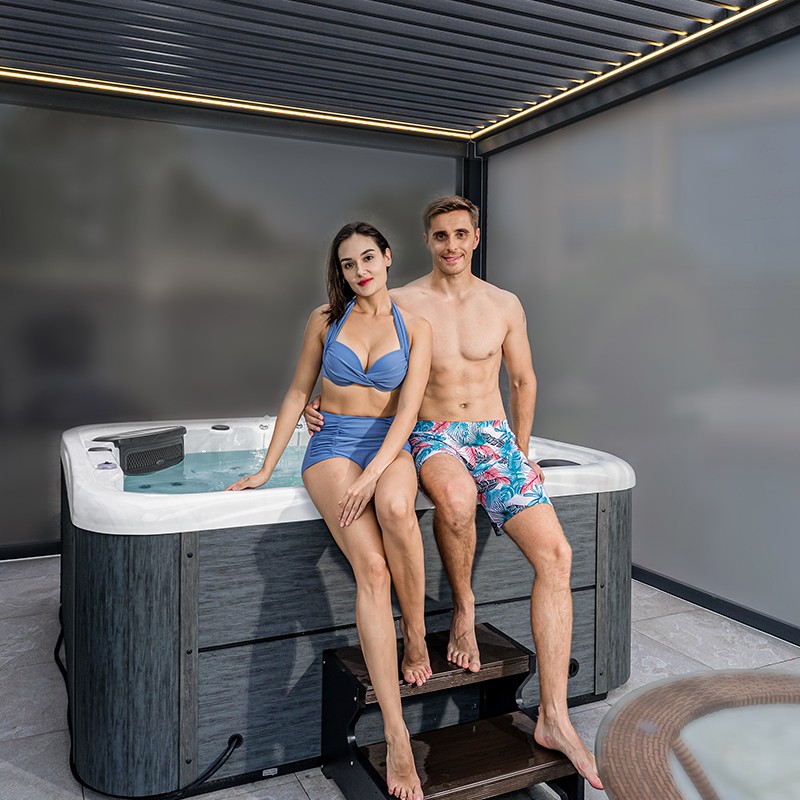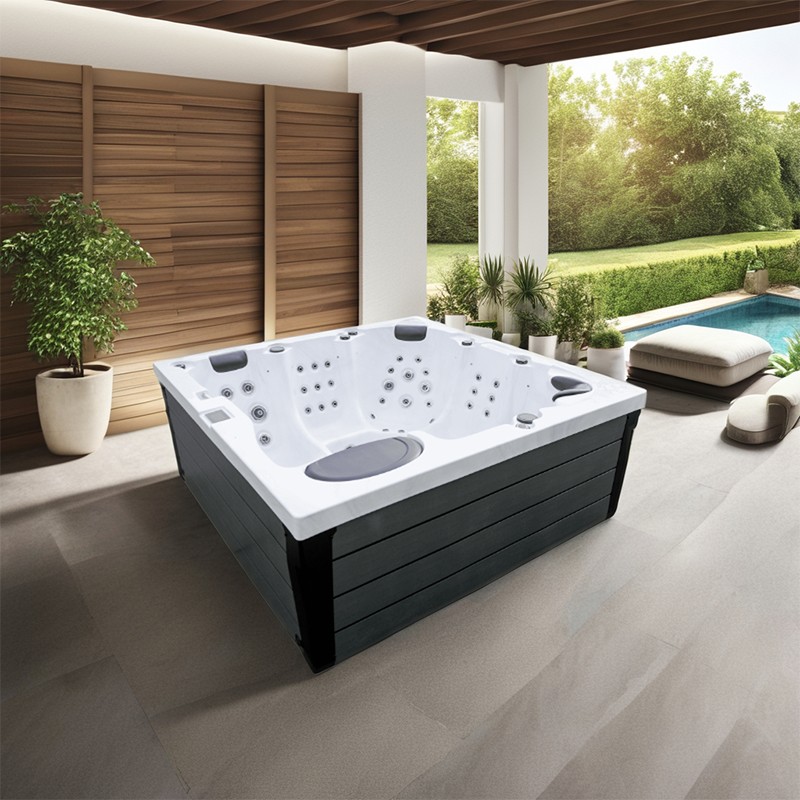
How long does it take to heat an outdoor hot tub to 40 degrees?
2024-11-11 15:30As a kind of equipment for people to relax and have fun, outdoor hot bathtubs have become one of the must-have facilities in many families. Especially in the cold season, soaking in a hot tub can not only relieve physical and mental fatigue, but also effectively relieve joint and muscle pain. However, how to quickly heat a hot tub to reach the ideal temperature of around 40 degrees is a concern for many people. For those who want to use the hot tub quickly, it is particularly important to understand the length of the heating process, the influencing factors, and how to heat it to 40 degrees more effectively.
This article will explore in detail the various factors that affect the heating time of an outdoor hot tub, and provide some suggestions to help users better control the heating time and ensure that the equipment serves the family in the best condition.

How long does it take to heat an outdoor hot tub to 40 degrees?
In general, the water temperature of an outdoor hot bathtub can rise by 2°C to 5°C per hour, depending on the heating power of the hot tub, the external ambient temperature, the capacity of the tub, and the insulation performance. Therefore, if the initial water temperature is to be heated from 10°C to 40°C, on average, it may take 6 to 12 hours.
However, this time is not fixed, and different brands and models of hot water tubs have different heating efficiencies. More importantly, the external ambient temperature and the initial temperature of the water source have a particularly significant impact on the heating time. The following is a detailed analysis of the impact of each factor on the heating time.
What are the main factors affecting the heating time of a hot tub?
The time it takes to heat an outdoor hot tub to 40 degrees is not determined by a single factor, but by the combined effect of multiple variables. Here are a few of the most important influencing factors.
Heater power
The power of the heater is the core factor that determines the heating speed. Typically, the power of hot tub heaters ranges from 1.5 kW to 11 kW. The greater the power, the faster the heating speed. For example, a 3kW heater heats up almost twice as fast as a 1.5kW heater.
Common home hot tubs are usually equipped with 3kW to 5kW heaters. For example, a 3kW heater can heat about 2°C to 3°C per hour. If you want to heat from 15°C to 40°C, it theoretically takes about 8 hours. In contrast, if it is a 5kW heater, the time required may be shortened to about 5 hours. Therefore, heater power is an important factor to consider when choosing a hot water tub.
Initial water temperature
The initial water temperature is another key factor. The time it takes to heat up a hot tub in the cold winter is very different from that in the warm summer. If the initial water temperature is low, such as 5°C or 10°C, it may take more time to reach 40°C. If the initial water temperature is close to room temperature or around 20°C, the heating time to reach 40°C will be greatly shortened.
Therefore, the difference in temperature between seasons and water sources will directly affect the heating process. When using a hot tub in winter, it is recommended to preheat it in advance, while in summer, due to the high ambient temperature, the heating time will be correspondingly reduced.
Water volume and tub capacity
The capacity of the hot water tub also directly affects the heating time. The larger the capacity, the more water needs to be heated, and the longer it takes for the water temperature to rise. Small hot tubs generally accommodate 2 to 4 people, while large ones can accommodate 6 to 8 people, and the water volume ranges from 300 to 800 gallons.
For example, a 400-gallon hot tub will heat up faster than a 600-gallon tub because the heater has less water to heat. Users can control the heating time by choosing the right tub size for the size of the family and their needs.
Outside Ambient Temperature
The temperature outside can also affect the heating speed. Cold weather can cause the water temperature to drop faster, especially without good insulation, which can cause the heater to take longer to raise the water temperature to 40°C. Conversely, in warm climates, the tub will heat up in a relatively short time.
When the outdoor temperature is low, heat can escape through the surface of the tub and through a loose lid. Therefore, keeping the tub lid tightly sealed and using good insulation in cold weather can effectively reduce heat loss and shorten the heating time.
Insulation of the tub
The insulation of an outdoor hot bathtub is also an important factor affecting the heating time. Good insulation can prevent heat from escaping through the tub's outer walls while keeping the water temperature stable during the heating process. In a poorly insulated tub, even when the heater is running at full capacity, the heat loss may be greater than the heat generated by the heater, resulting in a longer heating time.
Heat loss can be reduced by using an insulation cover, heat shield, etc., especially in low-temperature environments, where insulation is particularly important. Most high-end hot tubs use multiple layers of insulation to ensure efficient heating in cold weather.

How to optimize heating time?
Although there are many factors that affect the heating time of a hot water tub, there are still some ways for users to optimize the heating process and shorten the waiting time. Here are a few effective strategies:
Use an insulation cover
An insulation cover is the preferred tool for keeping the water in the hot tub warm. When the hot water tub is heated, the water surface is the place where heat is most likely to be lost. Using an insulation cover can greatly reduce heat loss, especially in low-temperature outdoor environments. Covering the cover while heating can significantly shorten the heating time.
A high-quality insulation cover can effectively lock in heat, prevent cold air from invading, and reduce the load on the heater. Regularly check the seal and material condition of the insulation cover to ensure that it can perform at its best.
Avoid opening the lid frequently
Opening the lid frequently during the heating process will cause the heat in the bathtub to be lost quickly, especially in cold weather. Each time the lid is opened, cold air will enter the bathtub, and the heater needs extra time to make up for the heat loss. Therefore, try to minimize the number of times the lid is opened during heating, and only open it briefly to confirm the water temperature.
Preheat in advance
If you plan to use the hot tub at a specific time, it is recommended to turn on the heater in advance to preheat. For example, if you plan to use the bathtub at 8 pm, you can start the heater in the afternoon so that the water temperature has reached the ideal 40°C when you use it.
Timed heating function is a common configuration of many hot tubs. Users can set the heating time according to their usage habits to avoid long waits for temporary heating.
Increase the initial water temperature
In cold seasons, if the water source temperature is very low, you can consider raising the initial water temperature appropriately. For example, filling the bathtub with warm water instead of cold water can greatly shorten the heating time. If the water source allows, using water close to room temperature will help speed up the heating process.
Choose an efficient heater
If your home hot tub takes too long to heat up, it may be caused by insufficient heater power. Upgrading to a higher-powered heater can significantly increase heating speed. Choosing a higher-powered heater may cost more initially, but it can save heating time and energy costs in the long run.

What is the relationship between heating time and energy consumption?
The length of heating time directly affects the energy consumption of the hot water tub. The longer the heating time, the greater the energy consumption. Therefore, shortening the heating time can not only improve the efficiency of use, but also save electricity or other energy consumption.
By regularly maintaining the heater, using an insulation cover, and reducing frequent opening of the cover, users can effectively control energy consumption and reduce daily use costs. At the same time, the rational use of the timing function to avoid unnecessary long heating times can also further save energy.
